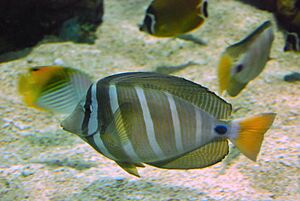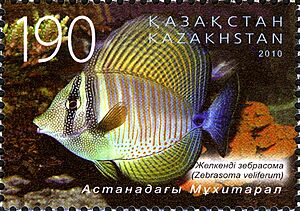Sailfin tang facts for kids
Quick facts for kids Sailfin tang |
|
|---|---|
 |
|
| Conservation status | |
| Scientific classification | |
| Synonyms | |
|
The sailfin tang (Zebrasoma velifer) is a beautiful fish that lives in the ocean. It's also known as the Pacific sailfin tang or sailfin surgeonfish. This fish is part of a family called Acanthuridae, which includes other cool fish like surgeonfishes and unicornfishes. You can find the sailfin tang swimming in the Pacific Ocean. Many people also like to keep them in their home aquariums.
Contents
About the Sailfin Tang's Name
Every living thing has a scientific name. The sailfin tang was first officially named Acanthurus velifer in 1795. A German scientist named Marcus Elieser Bloch gave it this name.
Later, in 1839, another scientist named William Swainson created a new group, or genus, for this fish. He called this group Zebrasoma. The sailfin tang was the first and only fish put into this new group at that time. This means it became the main example, or type species, for the Zebrasoma group.
The sailfin tang is very similar to the Indian sailfin tang (Z. desjardinii). Some scientists used to think they were the same species. These two fish are closely related.
What the Name "Velifer" Means
The scientific name velifer tells us something special about the fish. It comes from two Latin words:
- Velo means "sail".
- Fero means "to bear" or "to carry".
So, velifer means "sail-bearer". This name refers to the fish's very tall dorsal fin, which looks like a sail.
What the Sailfin Tang Looks Like
The sailfin tang has a body shaped like a disc. It has very tall dorsal and anal fins. When these fins are fully spread out, the fish's height is almost as much as its length! It also has a long snout, which is common for fish in the Zebrasoma group.
This fish is mostly brownish. It has wide grayish-brown stripes that go up and down its body. These stripes are separated by thinner yellow stripes. Its dorsal and anal fins are dark gray to brown with lighter bands. The tail fin can be grayish-brown or yellow.
The head of the sailfin tang is white with yellow spots. There's a dark stripe that goes through its eye. Another lighter stripe is just behind the eye. These head stripes also have yellow dots and lines. Young sailfin tangs look a lot like the adults, but they have more yellow color. This fish can grow up to about 40 centimeters (about 16 inches) long.
Where Sailfin Tangs Live
The sailfin tang lives in the Pacific Ocean. You can find them in many places, from Christmas Island in the eastern Indian Ocean all the way to Hawaii and the Pitcairn Islands in the Pacific. They live as far north as Japan and as far south as Australia. However, they are not found near the Marquesas Islands.
In Australia, they live near Rottnest Island and the Montebello Islands. They are also found around offshore reefs in Western Australia. You can see them at Ashmore reef in the Timor Sea and along the northern Great Barrier Reef. Young sailfin tangs have even been seen near Sydney. They also live around Middleton Reef, Elizabeth Reef, and Lord Howe Island.
Sailfin tangs usually live in lagoons and on reefs facing the open ocean. They can be found at depths of up to 45 meters (about 148 feet). Young fish often live alone on coral or rocky reefs that are sheltered. Sometimes, they might be found in cloudy water areas too.
Sailfin Tang Behavior and Diet
Sailfin tangs usually live by themselves. However, you might sometimes see them in pairs. They like to eat leafy algae, which they graze on.
These fish are active during the day. They usually find a mate and lay their eggs in the early afternoon. This often happens when the tide is going out.
Sailfin Tangs and People
People catch sailfin tangs for food in some places, like Guam. Fishers there use spears and fish traps to catch them. Because the sailfin tang is larger than some other tangs, like the yellow tang (Z. flavescens) and the twotone tang (Z. scopas), it is more valuable as a food fish.
The sailfin tang is also very popular in the aquarium trade. Many people enjoy keeping these beautiful fish in their home aquariums.



